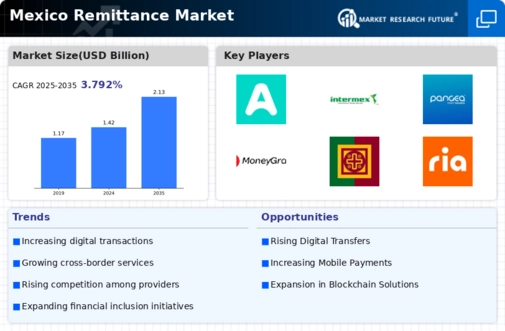Growing Diaspora Population
The increasing number of Mexicans living abroad contributes significantly to the remittance market. As of 2025, it is estimated that approximately 12 million Mexicans reside in the United States alone. This diaspora not only maintains strong ties with their families back home but also sends substantial financial support. In 2024, remittances to Mexico reached around $50 billion, indicating a robust flow of funds that bolsters the local economy. The remittance market in Mexico is thus heavily influenced by the size and economic capacity of this diaspora, which appears to be expanding steadily. As more individuals migrate for better opportunities, the potential for increased remittance flows seems likely to grow, further solidifying the importance of this market in Mexico.
Regulatory Framework Enhancements
The regulatory landscape surrounding the remittance market in Mexico is evolving, with authorities implementing measures to enhance transparency and security. Recent reforms aim to streamline the process for remittance service providers, ensuring compliance with anti-money laundering regulations. These changes may foster a more competitive environment, encouraging new entrants into the market. In 2025, it is anticipated that the number of licensed remittance operators will increase by 15%, reflecting a growing interest in this sector. Enhanced regulations not only protect consumers but also promote trust in the remittance market, potentially leading to increased transaction volumes. As the regulatory framework continues to develop, it may create opportunities for innovation and improved service delivery.
Economic Stability and Growth in Mexico
The overall economic environment in Mexico plays a crucial role in shaping the remittance market. As of November 2025, Mexico's GDP growth is projected at 3.5%, which may positively influence the demand for remittances. A stable economy encourages families to invest in education, healthcare, and housing, often funded through remittances. In 2024, remittances accounted for approximately 3% of Mexico's GDP, underscoring their significance in supporting economic activities. Furthermore, as the economy grows, the purchasing power of recipients may increase, leading to higher remittance inflows. This dynamic suggests that the remittance market will continue to thrive as long as economic conditions remain favorable, providing essential support to households across the country.
Cultural Ties and Family Support Systems
Cultural factors significantly influence the remittance market in Mexico. The strong emphasis on familial support and community ties drives many Mexicans abroad to send money home regularly. In 2024, surveys indicated that over 70% of remittance senders cited family obligations as their primary motivation for sending money. This cultural norm reinforces the flow of funds, as recipients often rely on these remittances for daily living expenses, education, and healthcare. The remittance market is thus deeply intertwined with social structures, suggesting that as long as these cultural values persist, the demand for remittances will remain robust. Additionally, the emotional connection to family may encourage senders to seek out the most efficient and cost-effective methods for transferring funds.
Technological Advancements in Transfer Services
Technological innovations are reshaping the remittance market in Mexico. The rise of mobile payment platforms and digital wallets has made it easier and more cost-effective for individuals to send money across borders. In 2025, it is projected that over 60% of remittance transactions will occur through digital channels, reflecting a shift from traditional methods. This transition not only enhances convenience but also reduces transaction fees, which can be as high as 7% for some services. As technology continues to evolve, the remittance market is likely to see increased competition among service providers, leading to better rates and services for consumers. The integration of blockchain technology may also emerge as a game-changer, potentially streamlining processes and enhancing security in transactions.

























Leave a Comment